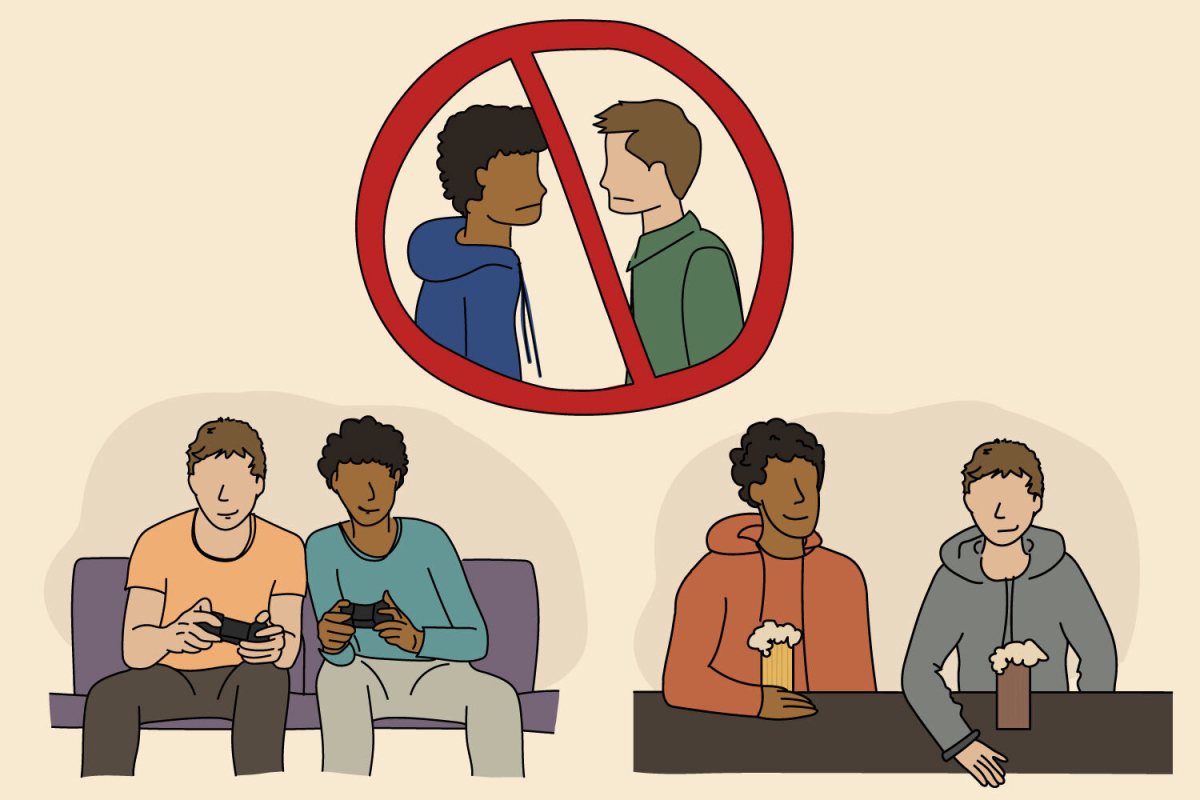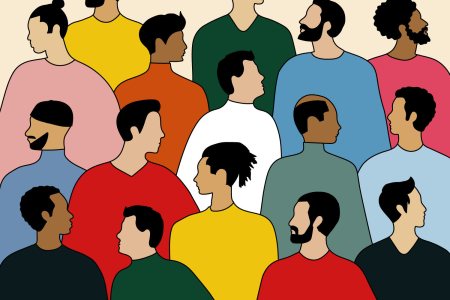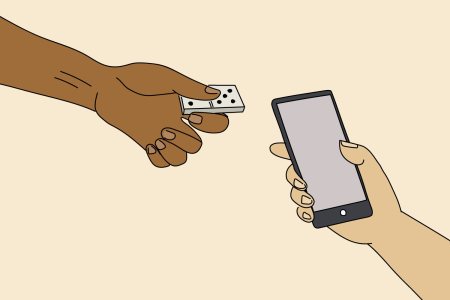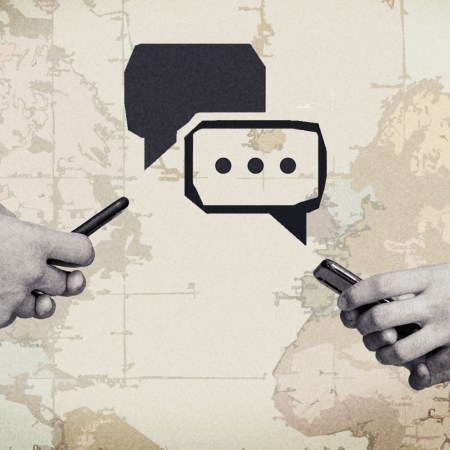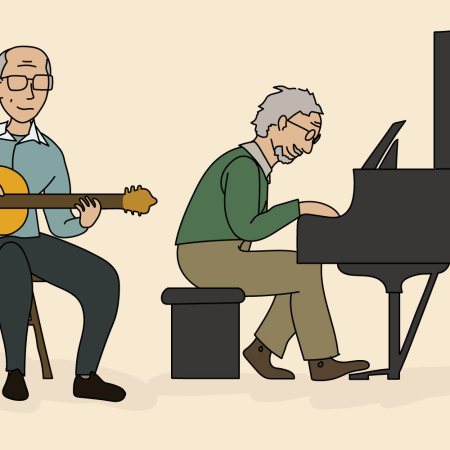During the month of April, we’re publishing a series of interviews, essays, advice columns and reported features about the male friendship crisis in the U.S., a particularly troubling slice of the country’s larger loneliness epidemic. There’s no one-size-fits-all solution, so we’re breaking it down from all angles in The Male Friendship Equation.
Last autumn, Norwich City Football Club posted a two-minute video to its social channels.
The East of England side isn’t well-known on a global scale — though it’s earned a few Premier League promotions in recent years — but this particular clip went decidedly viral. It was covered by bloggers in Australia, analyzed by marketing whizzes on LinkedIn and tallied tens of millions of views across Instagram, YouTube and TikTok.
In the video, two Norwich fans, both male and on the north side of 50, sit together in their designated supporters’ section seats and watch a full season of action — and we watch them. Sometimes it’s bright out, sometimes it’s chilly. Sometimes Norwich wins, often they don’t. The two friends make chit-chat about life, like Billy Crystal and Bruno Kirby at the Giants game in When Harry Met Sally.
At one point in the video, one of the men chuckles to the other, “Well I hope things are better outside of the football.”
He’s the more loquacious of the two. The one more likely to rise from his seat and cheer when something thrilling happens on the pitch. The happier one, your instincts would tell you — especially because the other man often appears mute, if not outright morose, like talking to the wind. You wonder how Mr. Sunny ever became so close with Mr. Cloudy, anyway, to the point that they sit beside each other, faithfully, season after season, year after year.
Near the end of the video, we learn that Mr. Sunny has taken his life. The last time we saw him, he lent his scarf to Mr. Cloudy; and at the end of the match, he kindly said, “Nah, you keep it mate!” In the next frame, his friend is draping it over an empty seat. The screen reads: “At times, it can be obvious when someone is struggling to cope. But sometimes, the signs are harder to spot.”
Norwich City produced the video for World Mental Health Day, in collaboration with Samaritans, a charity dedicated to suicide awareness and prevention. If the clip’s virality isn’t a sign that it’s struck a chord, there are responses like this, left in the comments section of the YouTube video:
“The first time you watch it, the ending blindsides you. If you watch it a second time, you see all the hints; him constantly asking how life has been [and hoping] for his buddy to ask the same…him finally leaving behind his prized possession with his friend.”
When I first watched the video, I cried. The narrative signaling is misleading by nature, but I didn’t feel duped. I felt unmoored, even ashamed that the ad’s ending hadn’t occurred to me, not for a single second. Of course, the video isn’t really about me (or you), I realized. It’s about all these smiling men suffering in the sun. Their situation is dire. According to the AMA Journal of Ethics, “While men are diagnosed with depression half as often as women and are less likely to attempt suicide, men die by suicide 3 to 4 times more frequently.”
The very last line of the Norwich City video is a gentle, yet urgent call to action: Check in on those around you, it reads. It seems like an extremely reasonable — even light — ask, given the circumstances. But still: how? Is there a right way for one grown man to engage, probe or interact with another, whether or not he fears for the other’s mental health?
In broad strokes, yes. Friendships thrive on a combination of empathy, reciprocity, vulnerability, curiosity. No one man is responsible for the emotional well-being of another man; but he can treat it like a living thing. He can nurture it, protect it, make mental note of how it’s doing. Like following a soccer club for decades or more. He can look it in the eye.
That’s the other thing that struck me while watching this ad: not once do the two men face one another. They’re well-versed in backslaps, elbow shots and celebratory claps. But their eye contact climaxes at noncommittal side-eye. Tellingly, it arrives whenever Mr. Sunny is fishing for conversation of substance. Would it have been easier to check in on one another had they been looking at each other?
The Male Friendship Equation: Meeting a Loneliness Crisis Head-On
Americans are increasingly isolated, especially men. This month, instead of despairing, we’re exploring the state of male friendship, warts and all.Side-by-side interaction is extremely common amongst men. It starts in boyhood. The motifs are familiar: playing video games next to each other, sitting at the bar, driving around town, carting up the fairway, fly-fishing in the shallows, grilling in the backyard, going for a run, watching the game. As a man, I can confidently say that many men take pride in the casualness of this brand of interconnection, when its nature even registers at all.
The gendered singularity here isn’t that men have a habit of doing things next to each other. It’s that we might prefer it to the intensity of looking each other in the eye. Or that we use it as a lily pad for our serious conversations, which, perhaps, might require more attention or consideration.
For some men, the easiest way to actually face each other involves props. Only when competing over a chess board, collaborating over a DIY project or tossing a ball back and forth from 15 yards apart can they get into it — only then does the good stuff have its permission to flow, as if some pressure valve has been released. I’d compare this phenomenon to Brad Pitt’s reliance on food in films; if he’s chewing on an apple, he’s looser, physically distracted yet emotionally more available, like he’s snuck through the back door to his sense of self. For my part, I can remember critical conversations with the male peers of my youth acted out as we traded a neon-orange Nerf football.
Is this aversion to face-to-face interaction normal? Is it healthy? It’s certainly generated concern from female partners and psychologists. Some have floated that men would rather not “challenge” each other with eye contact — it’s an evolutionary thing. Safer for them to sit beside each other in shared neutrality. You can imagine two male friends at a pavement cafe, having beers, watching the world go by. They’re catching up, but they’re also on low-humming alert; assessing threats and renewing their alliance in the jungle.
While that explanation for side-by-side interaction seems limited, I’m more taken with perspectives from sociologist and men’s studies expert Harry Brod, who posited that men actively “derive intimacy” from playing (or watching things) next to one another. The idea was echoed in this Reddit post about “‘guy secrets’ that girls don’t know about.” Men truly enjoy “side by side time,” the user wrote. “[Just] watching sports, playing boardgames, other hobbies and stuff…we rarely get past ‘how are you’ in terms of personal chat, but we all love it.”
Can Different Generations Truly Be Friends?
On social media, age groups have been condensed into antagonistic memes. Here’s how one Gen Zer and Gen Xer are bridging a widening generation gap.Is he right? Far from me — or a single Reddit user — to speak for an entire gender (and straight, cisgender men, in particular). But, if anything, I can comfortably say that there’s real truth in this. Side-by-side interaction can certainly encourage intimacy. It’s unique. It’s special. And it should be fiercely defended, at a time when men have fewer friends and are logging fewer interactions of any variety. (That’s what this male friendship business is all about.)
At the same time, though, how can any of us say that “all men love” this status quo? Who could possibly know that for sure? That same Reddit post waxes poetically: “You bond through the shared experience of the activity, not by talking to each other.” Is that really an effective prescription for lifelong friendship? Maybe this depends on what one means by “bonding” — or specifically, what either half wants or needs from a given relationship. Some friendships are kept at arm’s length by design. That’s fine. You can’t open up to everyone.
Still, we all have access to a basic, overarching rubric. I spelled it out before: empathy, reciprocity, vulnerability, curiosity. Look to women, who prioritize face-to-face interaction; who use the model in order to read faces, cross-reference tone or diction with expressions and display their own empathy, sympathy and understanding in return.
When men venture out into the world, when we spend time with people who aren’t our significant others, or children, or siblings, or parents, or colleagues — when we make a clear and conscious choice to spend our limited time with specific people — are we always, somehow, looking to be left alone? Is that all we want? To trade in mutters, mumbles and movie quotes?
I know men like to think (or project) that that’s enough. Many a meme has expressed something to the effect of “Men could sit around for hours coming up with former NFL runnings backs.” It’s true. But every man deserves a male friend to whom he can pour out the contents of his heart, without an accompanying fear of judgment or disgust.
Activities are special. Traditions are a treasure. And enough side-by-side interactions can pile up into the form of a happy, laughing and smiling life. But perhaps we men could shift to the left or right, just once in a while. After all, we smile with our eyes.
If you are having thoughts of suicide, call or text 988 or chat at 988Lifeline.org.
Whether you’re looking to get into shape, or just get out of a funk, The Charge has got you covered. Sign up for our new wellness newsletter today.
